Fall Color in the Sacramento Valley!
Why do leaves turn color in the fall?
This is right up there with 'how do they grow seedless watermelons?' among the most-asked questions directed at plant professionals.
The answer is simple! The days get shorter, the nights get colder, and Jack Frost magically paints the leaves in your yard!
Well, actually, the answer is more complicated, involving daylength (actually nightlength), temperature, nutrients, and genetics.
Trees that have adapted to cold winter climates go through several steps as winter approaches. The first part of the process is a reaction to longer nights. The plant forms a layer at the base of the leaves that blocks the movement of carbohydrates (sugars, starches) out of the leaves, and blocks the movement of minerals into the leaves. That 'abscission' layer eventually gets brittle and breaks, so the leaf falls.
 October Glory maple
October Glory maple
But before that happens, the plant produces less and less chlorophyll because it has less stuff to make it from. That is the pigment which makes leaves green. It is also the most fragile pigment, breaking down in sunlight very quickly. Usually the plant is replenishing it very quickly. But as it breaks down and becomes less abundant, the less common pigments of yellow and orange become visible. So these are the first fall colors that we see. Those colors were already there; we're just seeing them now because the green is gone. This first reaction mostly follows the calendar, although severely drought-stressed plants will begin to go dormant earlier than normal.
Some minerals are mobile within the plant, moving from one place to another as needed. The plant moves phosphorus out of the leaf and into the stem where it is stored during cold weather. The absence of phosphorus changes the chemical reaction in the leaves, and the remaining trapped carbohydrates are now made into certain other pigments, notably the ones that are red and purple. So these are the more spectacular colors that we see next. They weren't there before; the tree is making them now out of what's left in the leaf.
 Chinese pistache leaves
Chinese pistache leaves
Some trees make more of these pigments than others do, so it varies between species. There are also genetic differences of seedlings within a species. Variation in temperature from year to year, and the nutrient status of the specimen, also affects fall color. Within those species that have the pigments to begin with, sunny clear days and cool nights encourage the production of more red and purple pigments. A tree with adequate nutrition will have more basic material to work with to create pigment. Trees that are overwatered have damaged root hairs, so they've been unable to take up nutrients readily during the summer.
If you want to see these magical chemical reactions underway, head down West 8th Street and look for the Chinese pistache, or Stanford Place and Kent Drive to look for Ginkgo trees. Chinese pistache are planted all along Highway 113 and Interstate 80. Admire the golden yellow color on the Modesto ashes (Fraxinus) on L Streets and other parts of old East Davis, but we no longer recommend ash trees due to disease and mistletoe problems.
For vivid fall color in small spaces, plant Winged euonymus (Euonymus alatus 'Compacta'), an adaptable deciduous shrub with flame red fall foliage.
Trees for fall color in Davis:
a photo gallery |
| click to enlarge |
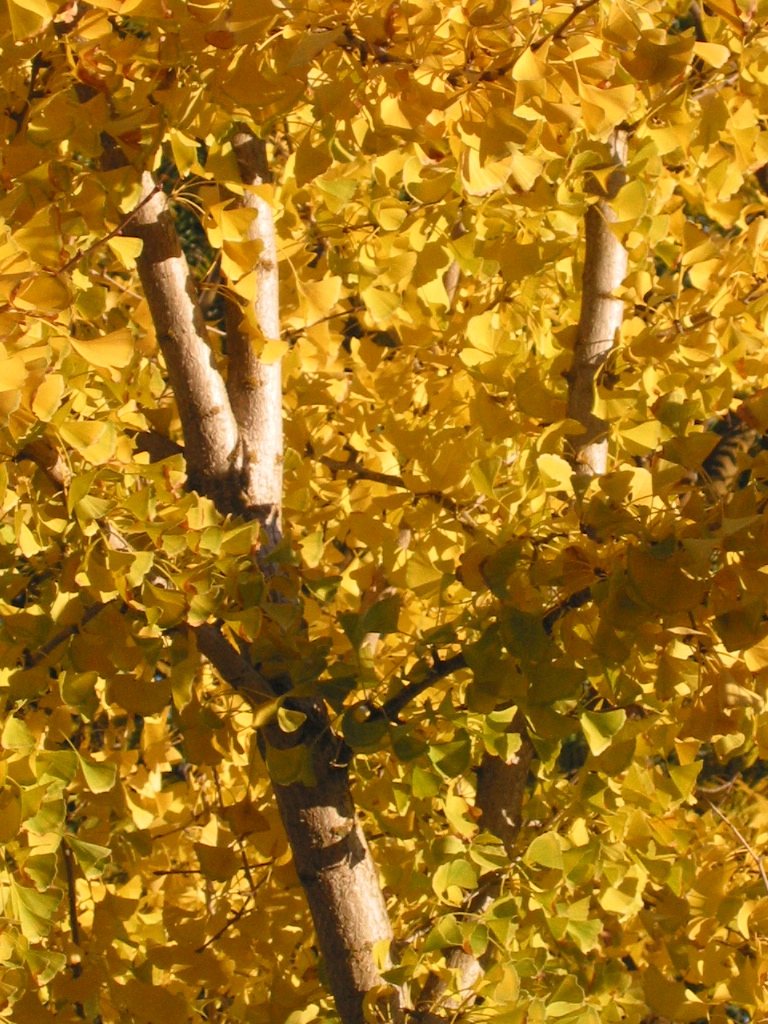
Ginkgo biloba Maidenhair tree
|
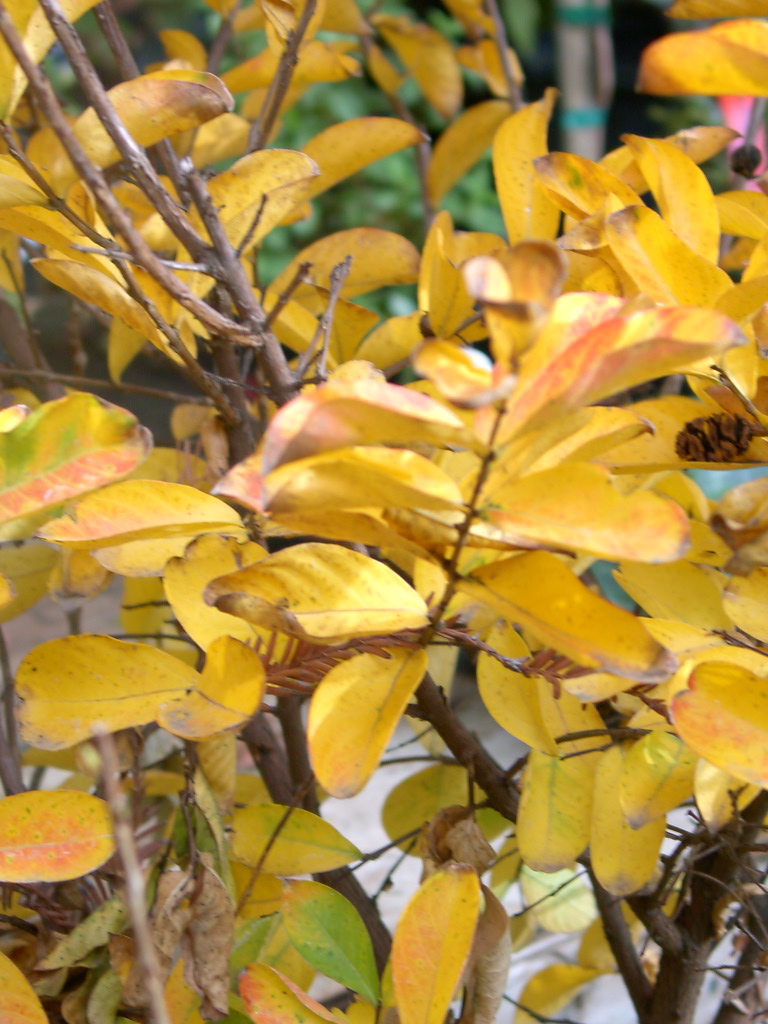
Lagerstroemia x Catawba Crapemyrtle |
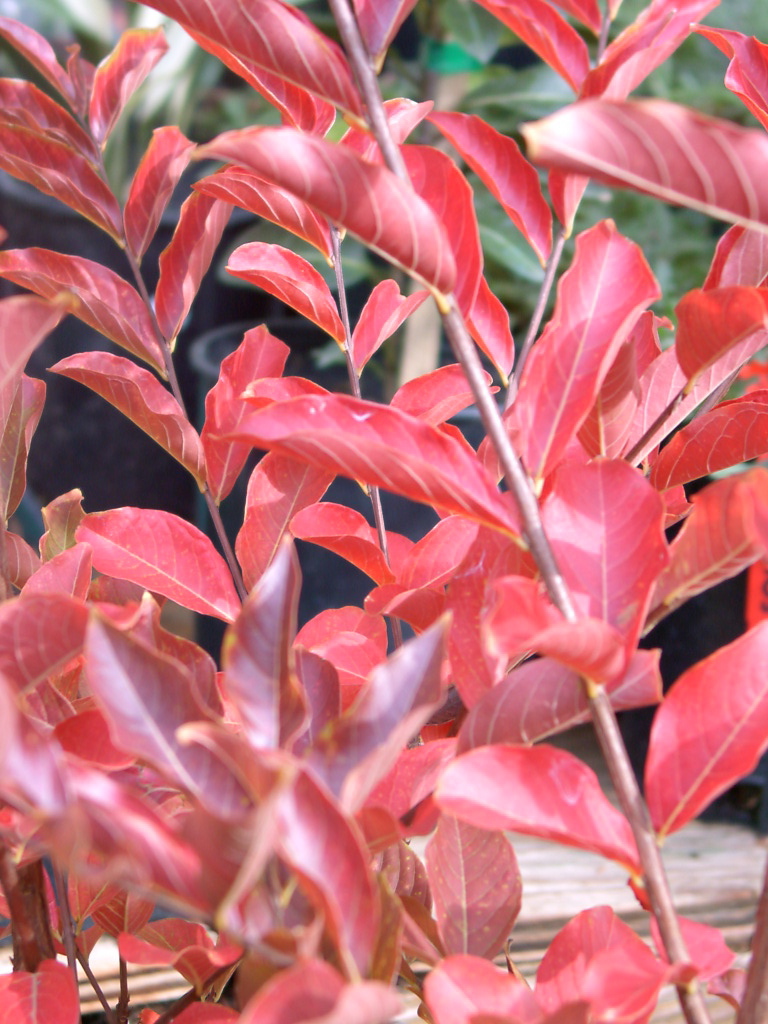
Lagerstroemia x Natchez Crapemyrtle |
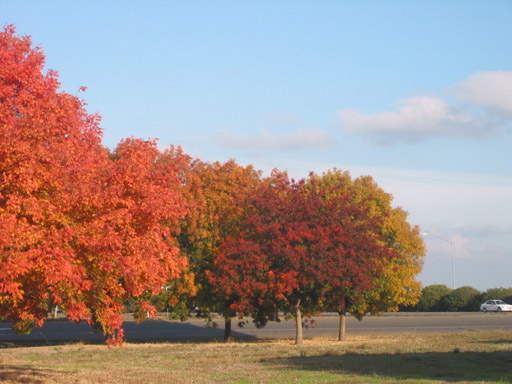
Pistacia chinensis Chinese pistache, mixed seedlings
|
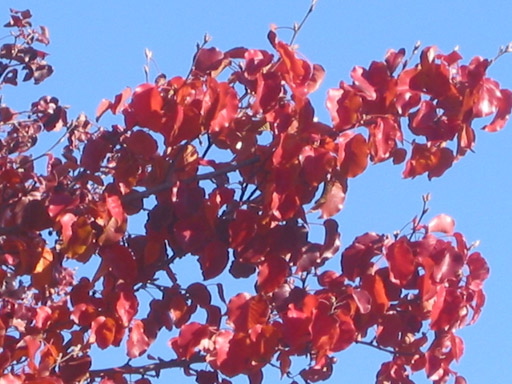
Pyrus calleryana Bradford pear |
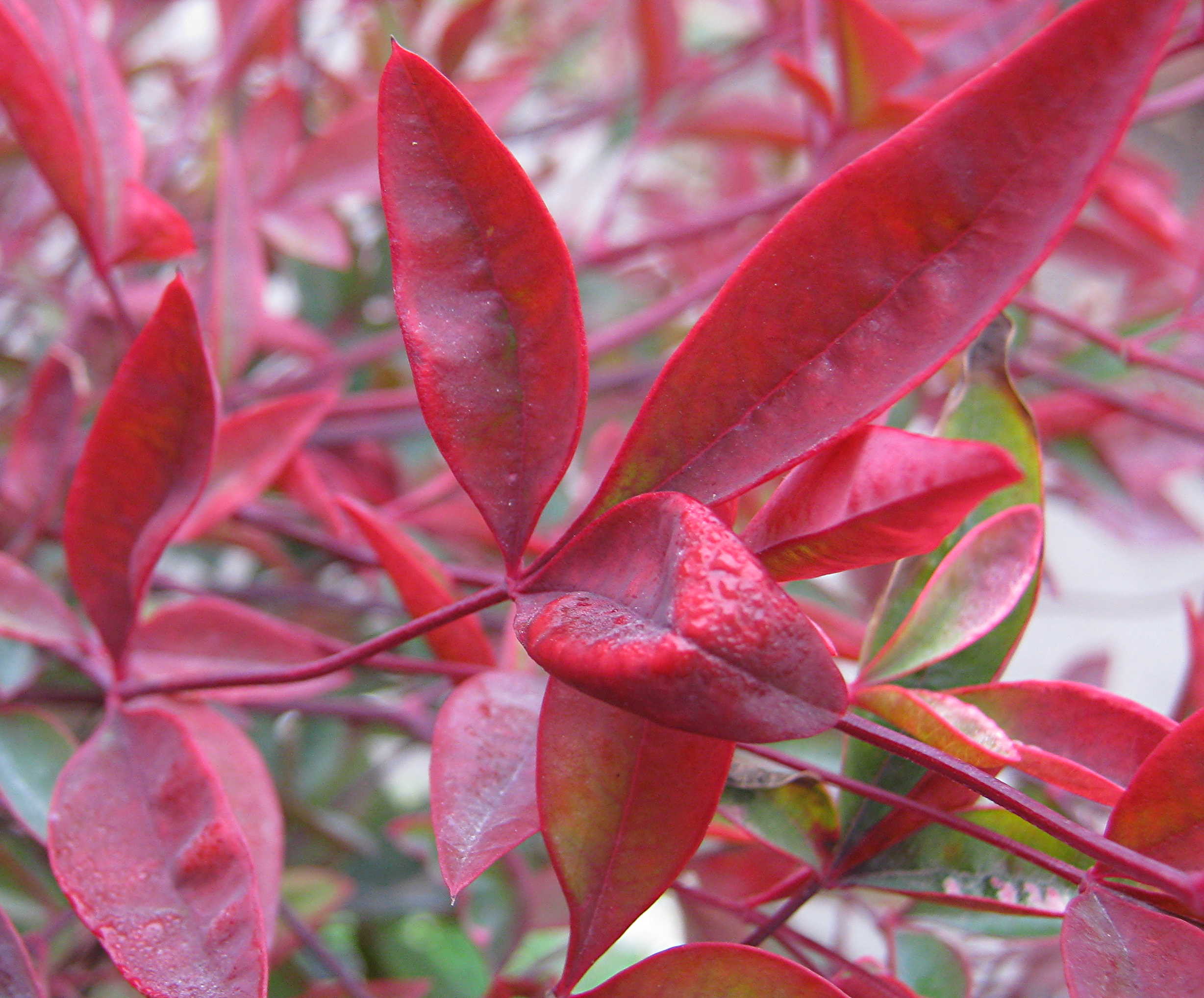
Nandina domestica 'Royal Princess' Heavenly bamboo |
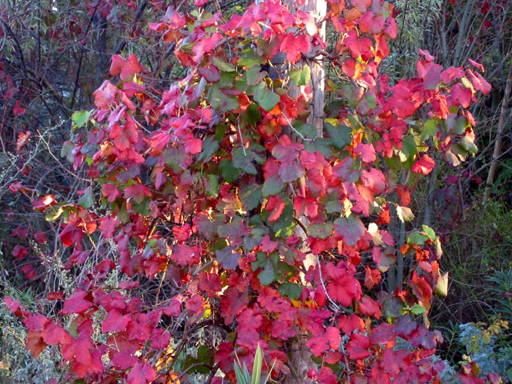
Vitis californica native California grape vine |
Chinese pistache
Pistacia chinensis
Most are grown from seed. Female trees have attractive red berries that attract song birds. Fall color varies from bright yellow to dark red. A male variety, Keith Davey, has reliable red fall color and no fruit. It is somewhat more expensive, as it is a grafted tree.
Crapemyrtle
Lagerstroemia indica and hybrids
Tree sizes range from 10' to 30' tall. Most are taller than broad, but a few have equal spread to height. Spectacular summer flowers, lovely exfoliating winter bark -- and very showy fall color on many varieties. Biloxi, Catawba, Dynamite, Muskogee, Tuscarora, and Zuni are orange-red to maroon; Natchez is bright yellow.
Ginkgo, Maidenhair tree
Ginkgo biloba
Varieties: just be sure to buy grafted male trees, as the fruit of the female tree smells like dog manure. And watch the young trees to make sure rootstock doesn't grow or you may end up with a female. Slow growers. Ginkgos are tough, reliable, and pest-free.
Maples
Acer rubrum hybrids; Acer x freemanii
Varieties: Autumn Blaze is biggest, fastest. October Glory has a nice round form. Red Sunset is slower growing. All have red fall color, ranging from orange to dark red.
Pears, ornamental
Pyrus calleryana
I'm including these because they are common in the area and have showy fall color, but they are mostly not recommended anymore. Varieties: Bradford is most common but has poor branch structure. Chanticleer, RedSpire, Trinity, Cleveland Select, Capital are all better, but all require careful pruning. White flowers in spring. All have wine red fall color.
Some other plants with fall color:
Euonymus alata 'Compacta'
Winged euonymus. Deciduous shrub with brilliant red leaves in fall. Interesting corky bark.
Parthenocissus species
Boston ivy, Virginia creeper. Clinging vines root into whatever they're growing on. Good in partial shade.
Rhus typhina
Staghorn sumac. Small tree suckers profusely to form thickets.
Vitis californica
More plant chemistry in the landscape
We see a similar reaction in broad-leaved evergreens such as Star jasmine (Trachelospermum) and Japanese boxwood (Buxus japonica), whereby they discolor in the winter during cold weather. Cold soil reduces the availability of phosphorus (the roots can't take it up), and overwatering or saturated soil conditions reduce the uptake of it because roots are damaged. So the phosphorus moves into the stem, and the leaves manufacture some of the purple or red pigments. But no abscission layer is formed, so they don't drop.
This is not a problem, and normal color returns with warmer weather. This winter coloration is attractive in some of our landscape plants: the white variegated portions of Euonymus fortunei 'Emerald Gaiety' turn a pretty pink color in the winter, and Heavenly bamboo (Nandina domestica) varieties turn varying shades of red or purple. Purple hopseed bush (Dodonea viscosa 'Purpurea') is a nice green shrub in the warm months, and turns a vivid burgundy-purple in the winter.
Some trees go through the pigment process, but don't form an abscission layer. Turkey and Red oaks are good examples (Quercus shumardii and Q. rubra). First a red pigment forms, which is rather pretty. Then that red pigment breaks down, and the brown, dead leaves hang on until they are finally beaten off during winter storms or pushed off as new growth emerges in the spring. Needless to say, this greatly reduces their ornamental value.
We get more questions.
When is our first frost?
First frost nearly every year that I've been here has been around Thanksgiving. But nights in the 40's make tropical plants unhappy, so bring your house plants inside now. Give 'em a good shower and make sure no ants are hitchhiking in, living in the potting soil! Then move them to the brightest window you have. The transition from outside lighting to inside can be a shock.
This would be a good time to assess your subtropical plants and figure out where they're going to spend the winter. Jade plants and others that are in pots can be moved up against the east or south facing walls, preferably under an overhang. Stick some stakes in the ground around young citrus trees and buy some 'seedling blanket' so you'll be ready to protect them if we get unusually cold nights.
Portions of this article are from a column written for the Davis Enterprise, October 27, 2005
© 2010 Don Shor, Redwood Barn Nursery, Inc., 1607 Fifth Street, Davis, Ca 95616
www.redwoodbarn.com
Feel free to copy and distribute this article with attribution to this author.
Click here for Don's other Davis Enterprise articles
